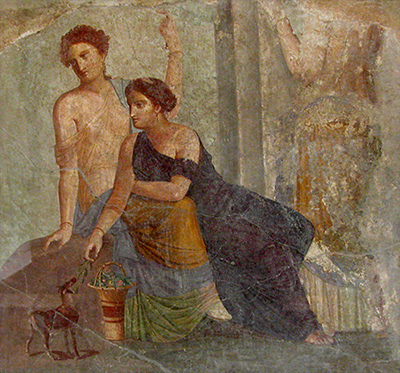 Women with a fawn, 1st century CE fresco, Pompeii |
The young woman to whom this poem is directed is given a name by the poet but no substantial reality. Who is Chloe? Is she an allusion borrowed from Greek lyric poetry, a testament to the poet’s erudition? Is she a Roman slave girl, a Greek hetaira as her name suggests, or a freeborn girl of a lower-class family whose burgeoning womanhood inspires the would-be lover-poet? Is she a poetic construct, a rhetorical device in imitation of the beloveds of Roman elegy? Chloe seems to be no more than a liminal object of male desire, the barely pubescent Greco-Roman puella. Although we know that upper-class Roman girls might be married as early as twelve years of age, the poet's artful pursuit of Chloe with reason and highly sensuous imagery is not directed toward marriage, so Horace's audience would not imagine her as belonging to the upper classes. The poem skillfully flatters Chloe's intelligence: the opening simile comparing her to a fawn evokes a poem by the sixth-century BCE Greek lyric poet Anacreon which exists today only in fragmentary form (see Anacreon 408). Describing Chloe’s innocent timidity as fawn-like, the poet argues that her fears are groundless and forcefully denies that he is pursuing her like a predatory beast. In the last stanza he convinces himself that she is indeed ready for him but the reader may wonder about Chloe's response. Has she been won over? Is she in fact free to give or withhold her assent to his appeal? The meter of the poem is the 4th Asclepiadean; its three four-line stanzas each consist of two lines composed in the 1st Asclepiadean meter, a third line in Pherecratean meter, a final line in Glyconic meter (see Horace meters). |
| Vitas inuleo me similis, Chloe, | ||
| quaerenti pavidam montibus aviis | ||
| 5 | Nam seu mobilibus veris inhorruit | |
| adventus foliis, seu virides rubum | ||
| Atqui non ego te, tigris ut aspera | ||
| 10 | Gaetulusve leo, frangere persequor: | |
Click on the underlined words for translation aids and
commentary, which will appear in a small window. Click on the icon link
![]() to the right of the
poem for related images and information.
to the right of the
poem for related images and information.